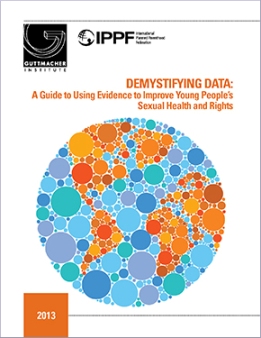
The Guttmacher Institute and the International Planned Parenthood Federation (IPPF) are pleased to launch Demystifying Data: A Guide to Using Evidence to Improve Young People’s Sexual Health and Rights, a new publication designed to make accessible and contextualize a wealth of data on adolescent sexual health and rights in 30 countries, and to provide guidance on how to apply the data to advocacy, education and service provision efforts. The guide is designed to be a resource for youth advocates, sexuality educators and service providers as well as others working to advance the sexual and reproductive health and rights of young people around the world.
IPPF and Guttmacher have long worked to increase public awareness about sexual and reproductive health issues and counter misinformation with sound scientific evidence. With this product, we are taking another step toward that goal, by explaining what the data represent in clear, accessible language and providing guidance as to how they can be effectively employed to promote better policies, improve service delivery and enhance sexuality education. The two organizations conceived and created this guide to assist those working on youth issues to increase their knowledge of available research evidence, and their ability to use this evidence as a foundation for their advocacy and other related activities.
The three core chapters of the guide highlight 70 key indicators on issues such as sexual activity and marriage; contraceptive knowledge, use and need; childbearing; sexuality education in schools; adolescents’ ability to advocate for and ensure their own sexual health; and societal norms and gender equality. The guide also presents information on the best ways to reach young people by providing information about their level of school attendance and exposure to different forms of media. Each indicator is defined and discussed in terms of how it can be employed in advocacy, service provision and sexuality education contexts.
The data featured in the guide come from nationally representative Demographic and Health Surveys for 30 countries. The countries covered are: In Africa, the Democratic Republic of Congo, Egypt, Ethiopia, Ghana, Kenya, Malawi, Mozambique, Nigeria, Rwanda, Senegal, Tanzania, Uganda, Zambia and Zimbabwe ; in Asia, Bangladesh, Indonesia, India, Nepal, Pakistan, the Philippines and Vietnam; in Latin America and the Caribbean, Bolivia, Colombia, the Dominican Republic, Guatemala, Honduras and Peru; and in Europe, Albania, Moldova and Ukraine. National-level data is provided for each of these countries in conjunction with the explanations of the indicators so that users can understand what is happening in their country and easily compare it to others in their region.
The printed guide also includes a CD-ROM with additional resources, including country-specific tables with breakdowns by subgroup (urban and rural; and five subgroups according to household economic status), detailed methodology and advocacy tools.
Click here to download the guide and below for the accompanying resources:
Country Tables
Sexuality Education Country Tables
Indicator Appendix
Advocacy guide
Démystifier les données : Guide pour utiliser les données disponibles afin d'améliorer la santé et les droits sexuels des jeunes
Desmitificando datos: Guía de uso de evidencia para mejorar la salud y los derechos sexuales de la gente joven
